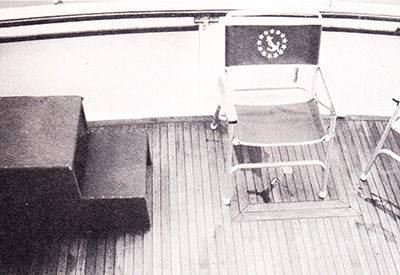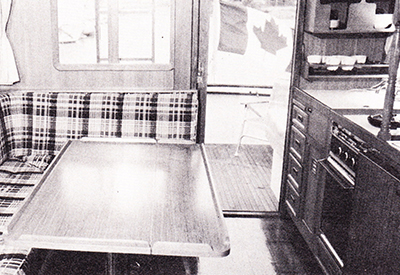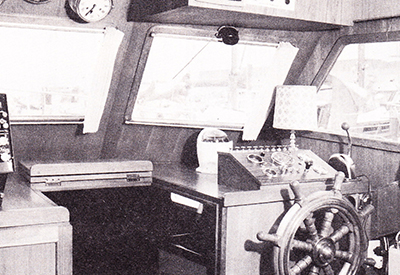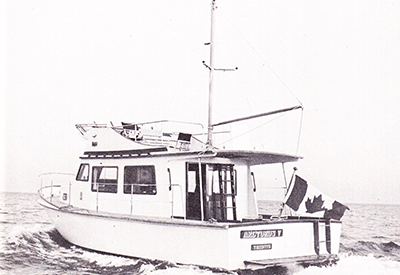Cheoy Lee Trawler 35
By Andy Adams
Like all Lloyd’s l00 Al spec yachts you can be sure the Cheoy Lee Trawler 35 is properly built, of the best materials, and will hold its value well. Jim Murray has reason to be proud.
Jack MacKenzie Yachts is the eastern Canadian distributor for Cheoy Lee and, in Toronto, the man you deal with is Jim Murray.
With his luxurious red beard and weather-etched twinkle in his eye, this man could be crawling across the Sahara Desert and you’d stop him to ask where he left his boat. He’s about the saltiest guy ever to live near fresh water.
Although he’ll sell you a Cheoy Lee, you’ll never quite get it away from him. Jim expects to see “his” boat every so often to inspect it and, if necessary, to clean it or work on it. There’s seldom a price attached to this, except that you’d better like Jim. Luckily, everybody seems to.
 When I arrived to run the test on “his” Cheoy Lee Trawler 35, he was busy working on another Cheoy Lee, readying it for a trip to Florida for the winter, and it was obvious that when Jim was finished, the boat would be ready for months of trouble-free sailing.
When I arrived to run the test on “his” Cheoy Lee Trawler 35, he was busy working on another Cheoy Lee, readying it for a trip to Florida for the winter, and it was obvious that when Jim was finished, the boat would be ready for months of trouble-free sailing.
He took a short break to familiarize me with the Trawler 35. It didn’t take much; the boat is straightforward and everything I could think of was how and where it should have been.
Cheoy Lee builds to Lloyd ‘s 100 Al specifications, like the Fisher Fairways Northeaster 30 tested in the August issue of Canadian Yachting. I commented then that the Lloyd’s 100 Al specs were about the best guarantee that a yacht is built properly, from the best materials and will hold its value well. Those comments apply equally to the Cheoy Lee Trawler 35.
 While Cheoy Lee ‘s boats are built to Lloyd’s specs, some buyers want more and go all the way for a certificate. That means that a Lloyd’s representative actually oversees the yacht ‘s construction through the various stages and later presents the buyers with a Lloyd’s certificate. The cost is in the thousands of dollars because of the time involved, but for many buyers the process is worth the price.
While Cheoy Lee ‘s boats are built to Lloyd’s specs, some buyers want more and go all the way for a certificate. That means that a Lloyd’s representative actually oversees the yacht ‘s construction through the various stages and later presents the buyers with a Lloyd’s certificate. The cost is in the thousands of dollars because of the time involved, but for many buyers the process is worth the price.
Our test 35 didn’t have the certificate, but the quality was there anyway. All you have to do is look.
The 35 is a conventional sedan model with flying bridge and at first glance you’d almost dismiss the boat as being rather plain. There’s no aft cabin, no bathtub, no shag carpet, nothing that isn’t functional and seaworthy – but there isn’t quite the price tag those things add either.
Unlike boats from Taiwan and other countries, the Hong Kong-built Cheoy Lee slips into this country without duty and excise costs. Late in October, our test Trawler 35 had a base of $100,000 and even the very complete collection of equipment included on this boat brought the price to only $122,500. That price is less than that for many other Oriental trawlers that can’t match the Lloyd’s specification Cheoy Lee.
 What we have here is a hand-laid fibreglass trawler, 34 ft 11 l/2 in. long on a beam of 12 ft even. She draws about 3 ft 7 in. and displaces roughly 23,000 lbs loaded. That’s without a ballasted keel, either; all the weight is in the boat and the equipment.
What we have here is a hand-laid fibreglass trawler, 34 ft 11 l/2 in. long on a beam of 12 ft even. She draws about 3 ft 7 in. and displaces roughly 23,000 lbs loaded. That’s without a ballasted keel, either; all the weight is in the boat and the equipment.
The sheer draws upward from the forward third of the boat to give a higher bow for foul weather, while the gunwale sides are relatively low for fishing and loading at dockside. Underwater, the shape is deep right through the forefoot to ‘midships, where the bottom rises rapidly to a broad, flat transom. The 35 is slightly rounded in the bilges, and the full keel is most pronounced at the stern where the bottom rises to the transom. There’s good protection for the prop and rudder, while a mild shaft angle is maintained for best efficiency.
The hull’s depth through ‘midships also offers a cavernous engine room as well as that favourable engine-mounting angle. When running, the boat is typical of trawlers in that it pushes a big bow wave and could never carry the power to plane, yet this boat seems to have a more slippery and sea kindly shape than some other trawlers I’ve tested. They’re all boxy and heavy, but this one seems somewhat more refined and leaves the water less disturbed. Really, since the Cheoy Lee people have been building for more than 100 years, you’d expect them to have the experience to get it right.
Topside, the boat is attractive but not distinctive. The cabin windows are very large, which is nice inside but makes the boat smaller, visually, from a distance. The flying bridge is integrated into the boat’s appearance and doesn’t suffer from that tacked-on look to which some boats fall victim, while the bridge floor extends well aft to offer weather protection for the cockpit.
 From an appearance and functional standpoint, one of the Cheoy Lee’s nicest features is the heavy spruce mast and boom assembly.
From an appearance and functional standpoint, one of the Cheoy Lee’s nicest features is the heavy spruce mast and boom assembly.
This is no toy rig. A steadying sail is optional (the test boat had it), and the mast is well up to the task of lifting the optional 7 ft 6 in. dinghy or cargo up to the bridge. For passage-making, the steadying sail serves well, although the boat would be a stable home afloat
under most circumstances anyway.
Cheoy Lee expects that its boats will be used in some pretty rough situations and therefore builds every part to be solid and able to support more than just a man’s weight. Deck, roof, bridge, anchor sprit and railings are solid, and over-built. You won’t find the Cheoy Lee wanting in a storm.
The gunwales are teak-capped and all the decking, cockpit and bridge sole is teak strip. The workmanship is first-class throughout. Having the teak running right out to an edge, for instance, lets water drain without lifting the teak. It’s solid and is laid over fibreglass for best water integrity.
 In the aft cockpit, the teak strip decking is carried to the lids of port and starboard storage boxes where safety gear and ground tackle are kept. For a 35, the cockpit is generous and left open by design. Cheoy Lee includes a centre transom door to accommodate swimmers using the optional swim grid. This is also often the easiest way to board at dockside – especially with an arm load of groceries.
In the aft cockpit, the teak strip decking is carried to the lids of port and starboard storage boxes where safety gear and ground tackle are kept. For a 35, the cockpit is generous and left open by design. Cheoy Lee includes a centre transom door to accommodate swimmers using the optional swim grid. This is also often the easiest way to board at dockside – especially with an arm load of groceries.
From the aft cockpit, a heavy teak ladder leads to the bridge, through a hatch in the roof. It’s a bit of a squeeze if you’re carrying something (the hatch could have been bigger), but it’s adequate.
The bridge itself, pleasant and large, has plenty of lockable storage space in the forward cowling where one can mount valuable electronics and stow safety gear. The helm position is comfortable either standing or seated on the centre bench seat. The upholstery is plain, to ward off mildew and rain; the instruments are covered as well.
 A very generous venturi windscreen is provided, but I can ‘t see why a skiff windscreen couldn’t be used. On a fast planing boat the venturi works well to deflect wind and even rain, at speed, but trawlers are seldom capable of more than about 10 knots and at such modest speeds the venturi simply doesn’t have the same effect. Instead, winds buffet you and rain blows in your face. Besides all that, you really can’t attach a decent top to a venturi and, personally, I’d far rather drive from above in any weather
A very generous venturi windscreen is provided, but I can ‘t see why a skiff windscreen couldn’t be used. On a fast planing boat the venturi works well to deflect wind and even rain, at speed, but trawlers are seldom capable of more than about 10 knots and at such modest speeds the venturi simply doesn’t have the same effect. Instead, winds buffet you and rain blows in your face. Besides all that, you really can’t attach a decent top to a venturi and, personally, I’d far rather drive from above in any weather
Everybody uses these venturi windscreens, but I guess I expected Cheoy Lee to have a better answer. Anyway. it was the only thing I could find to complain about.
The side decking is wide and well equipped with hand rails and grab rails. The boat has properly sorted anchor facilities, including a Cheoy Lee windlass that bears a striking resemblance to a Simpson Lawrence, 45 ft of chain rode, a 25-lb Danforth anchor, six stain less steel deck cleats and self-draining aft deck scuppers. All through-hulls have seacocks and filters, too. Nothing is missing.
The words “deck cleat” remind me of something Jim Murray told me. Despite the fact that I already was wearing deck shoes, he emphasized the point that no one was allowed on board without them. One of his friends, in bare feet,
had slipped and jammed one of the aforementioned massive cleats between his toes, up to the shin. I just winced.
 Boating stories are one of Jim’s greatest loves (next to Cheoy Lees) and we had plenty of time for them while running the Trawler 35 out into the lake. Enhancing the leisurely pace (about eight knots is a good cruise speed – 10 is tops), the boat’s owner had equipped her with an autopilot. This set, the 35 never deviated from course by more than a degree or so as long as we cruised, and the boat ‘s motions were very subdued despite a bit of a wind.
Boating stories are one of Jim’s greatest loves (next to Cheoy Lees) and we had plenty of time for them while running the Trawler 35 out into the lake. Enhancing the leisurely pace (about eight knots is a good cruise speed – 10 is tops), the boat’s owner had equipped her with an autopilot. This set, the 35 never deviated from course by more than a degree or so as long as we cruised, and the boat ‘s motions were very subdued despite a bit of a wind.
We wandered about, talking and exploring the Cheoy Lee ‘s finer points. An autopilot is well worthwhile on a trawler: when you’re making your way that slowly, being continually blown off course is an aggravation as much as it’s a waste of fuel and time. An autopilot is more economical by being more precise in steering than an owner could hope to be and in making the best course between two points. On a stormy trip from Toronto to Port Credit with another, similar trawler, Jim gained about 20 minutes even in that short distance using the autopilot. Heaving and yawing in bad weather is minimized, too, so passengers are more comfortable. The mast and boom assembly can carry an optional steadying sail or can be used to load cargo.
Comfort is a strong suit in the Cheoy Lee, but to add to that , our test boat had reverse-cycle heating and air conditioning. Built by Marine Air Systems, the pair of units blast air into the 35’s interior at whatever temperature you desire, though you have to run the generator for power when using the system away from dockside power. Our 35 had a 7.5 kilowatt Onan generator with sound shield and an Aqualift muffler for the purpose, and at first I didn’t realize it was running. At 2000 rpm, I recorded only 73 dB anyway and that was with no carpeting or sound-deadening in the very subdued despite a bit of a wind. We wandered about, talking and exploring the Cheoy Lee ‘s finer points. An autopilot is well worthwhile on a trawler: when you’re making your way that slowly, being continually blown off course is an aggravation as much as it’s saloon. The Cheoy Lee is a very quiet boat, a tacit reminder that she’s well built. I made the terrible mistake of saying to Jim that she would be even better with under padding and carpet; Jim will not have car pet covering the parquet on any of “his” boats. It’s not seamanlike.
Personally, I find parquet a bit too busy and would prefer to see strip flooring, but at least the parquet was well laid. Better than either is the teak grate flooring used in the head; that’s a really nice touch.
In the saloon one first finds a large convertible dinette and galley in the aft area. Bright plaid upholstery is cheerful and carefully stitched, while the woodwork is of superior quality throughout. The dinette converts into a berth 48 in. by 76 in., not super-wide, but long enough for tall people to feel at home aboard. There’s a minimum 6 ft 5 in. headroom in the saloon to go with the long berth. To port lies the galley. Optimus Princess three-burn er stove and oven,deep stainless steel single sink and Engel refrigerator are the basic ingredients, but the aft bulkhead-mounted dish rack , ample counter space and generous cupboard space make this the recipe for a very livable galley. Without telling anybody, the Cheoy Lee designers simply began add ing another dish cupboard at the forward counter end on the 35. It’s like them to make a running change without price change, and the cupboard is a good one. It floats on four lathe turned posts to leave counter space intact while adding more storage as well as a shelf on top.
This new feature does a good job of dividing the galley area from a forward convertible couch, too. Cheoy Lee includes this couch, a coffee table and all the other needed item s of decor as standard equipment.
At the front of the saloon lies the interior helm, as complete as the bridge helm and with electrical controls and breaker box located near at hand. The view out is good, and the dashboard is well designed for mounting radar and other large or cumbersome pieces of equipment. An overhead console houses the autopilot, depth sound er and radios, plus a clock and barometer which were owner-installed.
Other than the saloon, the 35 has only a head and forward cabin. The head is beautifully finished, with hot and cold running water, a shower, Wilcox head, porthole with curtains and screens, towel racks, storage lockers and 110V power outlets. The shower can be handheld and uses a track curtain instead of a stall. That’s why the teak grate flooring is so nice, and there’s 6 ft 5 in. of headroom here, too.
The forward cabin has a berth 7 ft long by 4 ft wide with two drawers and two locker s beneath as well as lockers all around the sides and a small couch to starboard. All the shelving has sea rails and the teak trim and dressing table make the whole cabin quite livable.
Jim wasn’t keen to spend a lot of time showing off the interior – he wanted me down in the engine room, where the Lloyd’s specs are most valuable. It’s big, and has a textured aluminum floor. When diesel fuel spills on plywood flooring, the smell never leaves until you replace it; the aluminum is far easier to clean, safer and, to go all the way, Cheoy Lee adds a removable stainless steel drip pan under the engine.
The single Ford Lehman diesel is a common feature for most trawlers, being economical, reliable and fairly easy to work on. Here, it’s very open on all sides, but twins would make the engine room more awkward. Twin side tanks carry a most generous 630 gal US, and drain down simultaneously to maintain trim. Water separators are included, as are twin 120-ampere-hour batteries, all copper plumbing, raw water sea strainers and fresh water cooling on the engine.
Out on the water, the Ford Lehman cruises easily at eight knots for a range of approximately 2,700 miles, though running the 7.5 Onan will cut into that maximum figure. With the autopilot and the Wagner Hydraulic steering, however, the Lehman should make a comfortable 1,000 miles, no matter what.
The interior layout that seemed plain and conventional at first becomes very accommodating and spacious after a short time, and the obvious careful planning that has gone into all aspects of the 35’s design will ensure that a cruising couple won’t find this yacht wanting over a long passage.
Ordinarily, I at least get to comp lain that single-engine yachts are difficult to control at dockside, but with his enthusiasm still running high, Jim pulled the 35 back into her slip in a stiff breeze by using engine torque just as one would with twins. A perfect landing.
With the price well in line with the competition, the Cheoy Lee deserves serious consideration.
Originally published in Canadian Yachting’s January 1981 issue.
Specifications:
Length – 34ft 11in
Beam – 12ft
Draft – 3ft 7in
Weight – 21,000
Fuel Capacity – 650 gal
Waste Capacity – 30 gal
Water Capacity – 210 gal
Hull Type – Semi Disp.
Photo Captions:
Photo 1 – Typical of trawlers, the Cheoy Lee pushes a big bow wave. Sheer draws upward from forward third of the boat to give a higher bow.
Photo 2 – Topside, the boat’s attractive but not distinctive.
Photo 3 – Galley and Dining area.
Photo 4 – A 25-lb Danforth anchor is accompanied by 45 feet of chain rode.
Photo 5 – Like the bridge, the interior helm is complete, with controls near at hand and a good view out.
Photo 6 – Cockpit area is generous with a centre transom door for swimmers and port and starboard storage lockers.
Photo 7 – Water separators, copper plumbing, raw water sea strainers and fresh water engine cooling are included.
Photo 8 – The engine is a Ford Lehman diesel with twin side tanks carrying 630 US gallons draining simultaneously.























